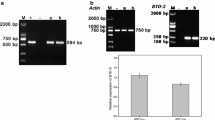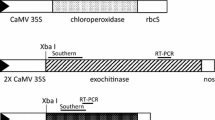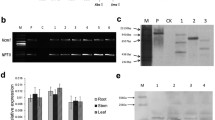Abstract
The main pathogen of Gladiolus plants is Fusarium oxysporum, a soilborne fungus that infects roots and corms resulting in death of the plant. Purified D4E1, a synthetic antimicrobial peptide, was previously reported (De Lucca et al. 1998) to inhibit F. oxysporum spores from forming mycelial colonies in vitro at a concentration of 3 μM making it a candidate gene for genetic engineering of Gladiolus for resistance to F. oxysporum. Gladiolus cv. Peter Pears plants were transformed by particle bombardment with plasmid DNA containing a 90 bp D4E1 gene that was under the control of the duplicated CaMV 35S promoter. Five of the 14 independently transformed plant lines were evaluated for resistance to F. oxysporum. Transgenic plants were tested in vitro for resistance to F. oxysporum, and several lines appeared to be more resistant than the control plants that lacked D4E1. Cell extracts of transgenic Gladiolus lines 6(1) and 7(1) inhibited germinated spores of F. oxysporum f. sp. gladioli from forming mycelial colonies by 34 and 38 %, respectively, in vitro. F. oxysporum f. sp. gladioli was transformed with the ECFP (cyan) gene allowing us to follow the growth of F. oxysporum during infection of D4E1-transformed and non-transformed roots. Fluorescence observations using confocal laser scanning microscopy showed that 3–10 days after infection, F. oxysporum covered the surface of the root and formed pseudo-appressoria, but hyphae were never observed to penetrate cells of the root. Ten days after infection with F. oxysporum, non-transformed roots had completely disintegrated whereas transgenic roots of line 7(1) were just beginning to lose their cellular integrity. Cell extracts from the five transgenic lines showed either an inhibition of F. oxysporum mycelial colony formation or less fungal hyphae were observed to infect their roots as compared to non-transformed Gladiolus plants.





Similar content being viewed by others
Abbreviations
- 2,4-D:
-
2,4-dichlorophenoxyacetic acid
- Fog :
-
Fusarium oxysporum f. sp. gladioli
- MIC:
-
Minimum inhibitory concentration
- MS:
-
Murashige and Skoog’s medium
- PDA or PDB:
-
Potato dextrose agar or broth medium
References
Abdallah NA, Shah D, Abbas D, Madkour M (2010) Stable integration and expression of a plant defensin in tomato confers resistance to Fusarium wilt. GM Crops 1:344–350
Cary JW, Rajasekaran K, Jaynes JM, Cleveland TE (2000) Transgenic expression of a gene encoding a synthetic antimicrobial peptide results in inhibition of fungal growth in vitro and in planta. Plant Sci 154:171–181
Chakrabarti A, Ganapathi TR, Mukherjee PK, Bapat VA (2003) MSI-99, a magainin analogue, imparts enhanced disease resistance in transgenic tobacco and banana. Planta 216:587–596
Chan Y-L, Sanjaya VP, Chen KH, Liu PC, Chan M-T, Cheng C-P (2005) Transgenic tomato plants expressing an Arabidopsis thionin (Thi2.1) driven by fruit-inactive promoter battle against phytopathogenic attack. Planta 221:386–393
Cyzmmek KJ, Fogg M, Powell DH, Sweigard J, Park S-Y, Kang S (2007) In vivo time-lapse documentation using confocal and multi-photon microscopy reveals the mechanisms of invasion into the Arabidopsis root vascular system by Fusarium oxysporum. Fungal Gen Biol 44:1011–1023
De Lucca AJ, Bland JM, Grimm C, Jacks TJ, Cary JW, Jaynes JM, Cleveland TE, Walsh TJ (1998) Fungicidal properties, sterol binding, and proteolytic resistance of the synthetic peptide D4E1. Can J Microbiol 44:514–520
Dellaporta S, Wood J, Hicks J (1983) A plant DNA minipreparation: version II. Plant Mol Biol Rep 1:19–21
Epple P, Apel K, Bohlmann H (1997) Over expression of an endogenous thionin enhances resistance of Arabidopsis against Fusarium oxysporum. Plant Cell 9:509–520
Fox JL (2013) Antimicrobial peptides stage a comeback. Nature Biotech 31:379–382
Goyal RK, Hancock REW, Mattoo AK, Misra S (2013) Expression of an engineered heterologous antimicrobial peptide in potato alters plant development and mitigates normal abiotic and biotic responses. PLoS One 8:e77505
Gygi SP, Rochon Y, Franza BR, Aebersold R (1999) Correlation between protein and mRNA abundance in yeast. Mol Cell Biol 19:1720–1730
Kostov K, Christova P, Slavov S, Batchvrova R (2009) Constitutive expression of a radish defensin gene RS-AFP2 in tomato increases the resistance to fungal pathogens. Agric and Environ Biotech 23:1121–1125
Lakshman D, Pandey R, Kamo K, Bauchan G, Mitra A (2012) Genetic transformation of Fusarium oxysporum f.sp. gladioli with Agrobacterium to study pathogenesis in Gladiolus. Eur J Plant Pathol 133:729–738
Larone DH (1995) Medically important fungi, a guide to identification, 3rd edn. American Society for Microbiology Press, Washington
Lee OS, Lee B, Park N, Koo JC, Kim YH, Prasad DT, Karigar C, Chun HJ, Jeong BR, Kim DH, Nam J, Yun J-G, Kwak S-S, Cho MJ, Yun D-J (2003) Pn-AMPs, the hevein-like proteins from Pharbitis nil confers disease resistance against phytopathogenic fungi in tomato, Lycopersicum esculentum. Phytochemistry 62:1073–1079
Lee SC, Hwang IS, Choi HW, Hwang BK (2008) Involvement of the pepper antimicrobial protein CaAMP1 gene in broad spectrum disease resistance. Plant Physiol 148:1004–1020
Li C, Chen S, Zuo C, Sun Q, Ye Q, Yi G, Huang B (2011) The use of GFP-transformed isolates to study infection of banana with Fusarium oxysporum f. sp. cubense race 4. Eur J Plant Pathol 131:327–340
Li C, Shao J, Wang Y, Li W, Guo D, Yan B, Xia Y, Peng M (2013) Analysis of banana transcriptome and global gene expression profiles in banana roots in response to infection by race 1 and tropical race 4 of Fusarium oxysporum f. sp. BMC Genomics 14:851–867
Maniatis T, Fritsch EF, Sambrook J (1982) Molecular cloning: a laboratory manual. Cold Spring Harbor Laboratory Press, Cold Spring Harbor, pp 368–369
Mendgen K, Hahn M, Deising H (1996) Morphogenesis and mechanisms of penetration by plant pathogenic fungi. Ann Rev Phytopathol 34:367–386
Mentag R, Luckevich M, Morency M-J, Séguin A (2003) Bacterial disease resistance of transgenic hybrid poplar expressing the synthetic antimicrobial peptide D4E1. Tree Physiol 23:405–411
Michielse CB, Rep M (2009) Pathogen profile update: Fusarium oxysporum. Mol Plant Path 10:311–324
Murashige T, Skoog G (1962) A revised medium for rapid growth and bioassays with tobacco tissue cultures. Physiol Plant 15:473–497
Nosir W, McDonald J, Woodward S (2011) Impact of biological control agents on fusaric acid secreted from Fusarium oxysporum f. sp. gladioli (Massey) Snyder and Hansen in Gladiolus grandiflorus corms. J Ind Microbiol Biotechnol 38:21–27
Oard SV, Enright FM (2006) Expression of the antimicrobial peptides in plants to control phytopathogenic bacteria and fungi. Plant Cell Rep 25:561–572
Ori N, Eshe Y, Paran I, Presting G, Aviv D, Tanksley S, Zamir D, Fluhr R (1997) The 12C family from the wilt disease resistance locus 12 belongs to the nucleotide binding, leucine-rich repeat superfamily of plant resistance genes. Plant Cell 9:521–532
Pelegrini PB, Perseghini del Sarto R, Silva ON, Franco OL, Grossi-de-Sa MF (2011) Antibacterial peptides from plants: what they are and how they probably work. Biochem Res Int 250349:1–9
Rajasekaran K, Stromberg KD, Cary JW, Cleveland TE (2001) Broad-spectrum antimicrobial activity in vitro of the synthetic peptide D4E1. J Agric Food Chem 49:2799–2803
Rajasekaran K, Cary JW, Jaynes JM, Cleveland TE (2005) Disease resistance conferred by the expression of a gene encoding a synthetic peptide in transgenic cotton (Gossypium hirsutum L.) plants. Plant Biotech J 3:545–554
Remotti PC, Van Harmelen MD, Löffler HJM (1997) In-vitro selection for Fusarium-resistance in Gladiolus. Acta Hort 430:605–610
Sanford J, Smith FD, Russell JA (1993) Optimizing the biolistic process for different biological applications. Methods Enzymol 217:483–510
Straathof TP, Roebroeck EJA, Loffler HJM (1998) Studies on Fusarium–Gladiolus interactions. J Phytopathol 146:83–88
Tsai-Morris CH, Sheng Y, Lee E, Lei KJ, Dufau ML (2004) Gonadotropin-regulated testicular RNA helicase (GRTH/Ddx25) is essential for spermatid development and completion of spermatogenesis. Proc Natl Acad Sci USA 101:6373–6378
USDA Floriculture Crops 2012 Summary (http://usda.mannlib.cornell.edu/usda/current/FlorCrop/FlorCrop-06-19-2014)
van der Weerden NL, Bleackley MR, Anderson MA (2013) Properties and mechanisms of action of naturally occurring antifungal peptides. Cell Mol Life Sci 70:3545–3570
Acknowledgments
Mention of a trademark, proprietary product or vendor does not imply its approval to the exclusion of other products or vendors that may also be suitable. Chris Pooley (USDA, Beltsville, MD) is thanked for assistance with preparing the confocal microscopy figures. Siobhan O’Connor provided excellent technical assistance with the Southern hybridizations and RT-PCR. The Fog was received from Professor Robert McGovern (Univ. of Florida, Gainesville, FL). Assistance with the spore germination experiments were provided by Ruichi Pandey and Bula Choudhury.
Conflict of interest
None of the authors have any conflict of interest with this research.
Author information
Authors and Affiliations
Corresponding author
Electronic supplementary material
Below is the link to the electronic supplementary material.
Rights and permissions
About this article
Cite this article
Kamo, K., Lakshman, D., Bauchan, G. et al. Expression of a synthetic antimicrobial peptide, D4E1, in Gladiolus plants for resistance to Fusarium oxysporum f. sp. gladioli . Plant Cell Tiss Organ Cult 121, 459–467 (2015). https://doi.org/10.1007/s11240-015-0716-4
Received:
Accepted:
Published:
Issue Date:
DOI: https://doi.org/10.1007/s11240-015-0716-4




